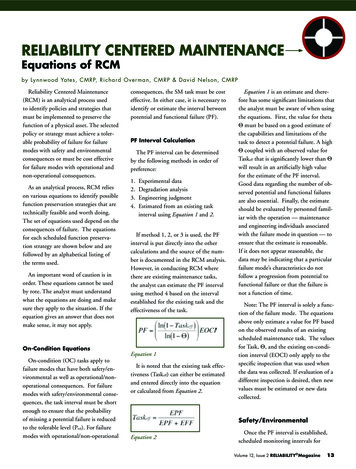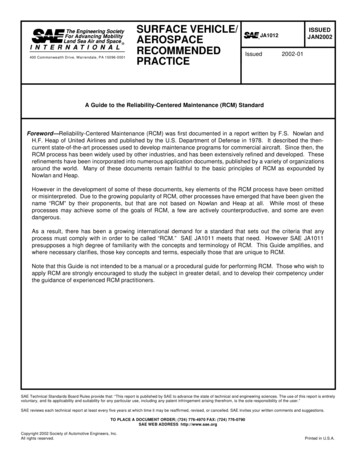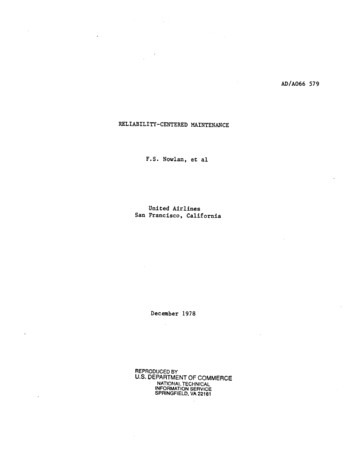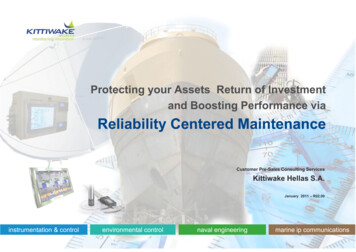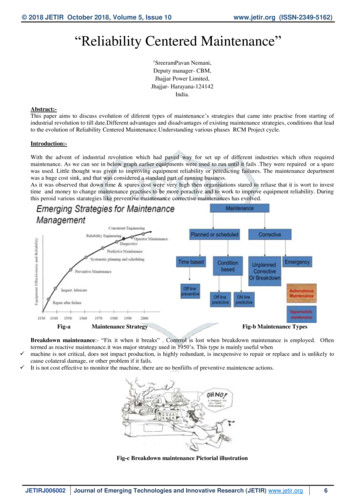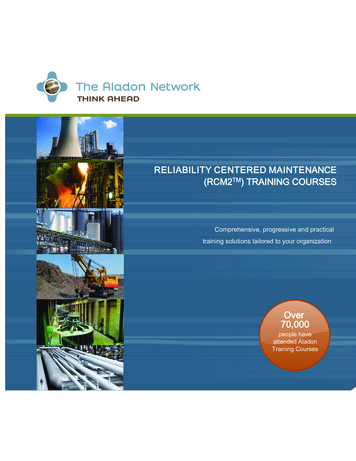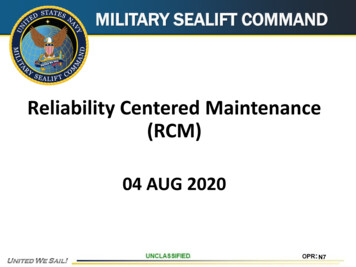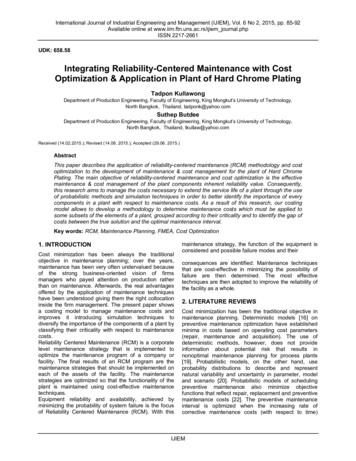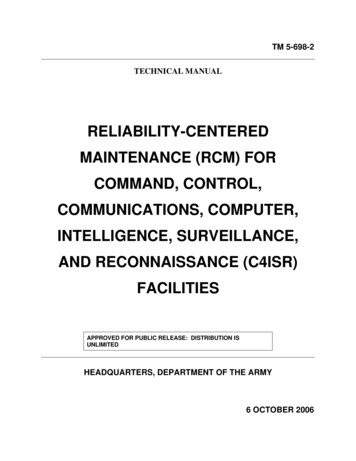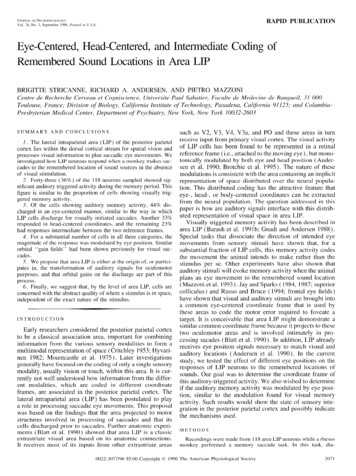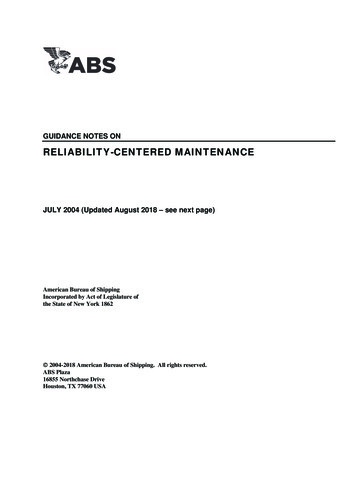
Transcription
Guidance Notes on Reliability-Centered MaintenanceGUIDANCE NOTES ONRELIABILITY-CENTERED MAINTENANCEJULY 2004 (Updated August 2018 – see next page)American Bureau of ShippingIncorporated by Act of Legislature ofthe State of New York 1862 2004-2018 American Bureau of Shipping. All rights reserved.ABS Plaza16855 Northchase DriveHouston, TX 77060 USA
UpdatesAugust 2018 consolidation includes: July 2004 version plus Corrigenda/Editorials
ForewordForewordIn recent years, there has been an increase in the use of proactive maintenance techniques by Owners forrepair and maintenance of machinery onboard vessels and offshore structures. The resulting preventativemaintenance programs developed as a result of applying these techniques are being used by the vessel’s crewand shore-based repair personnel. There have been numerous advances in condition monitoring technology,trending, and increasingly more powerful planned maintenance software as a result of increased businesscompetition. Since 1978, ABS has cooperated with Owners on developing and implementing preventativemaintenance programs. In 1984, ABS issued its first Guide for Survey Based on Preventative MaintenanceTechniques with subsequent updates in 1985, 1987, 1995 and then inclusion in the Rule Requirements forSurvey After Construction (Part 7) in mid-2002.However, machinery systems have continued to become larger and more complex, requiring skilled operatorswith specialized knowledge of the machinery and systems onboard. The Guide for Survey Based onReliability-centered Maintenance was issued in December 2003 to provide vessel and other marine structureOwners, managers and operators requirements for the development of a maintenance program using techniquesapplied in other industries for machinery systems within a maintenance philosophy referred to asReliability-centered Maintenance (RCM). With the application of RCM principles, maintenance is evaluatedand applied in a rational manner that provides the most value to a vessel’s Owner/manager/operator.Accordingly, improved equipment and system reliability onboard vessels and other marine structures canbe expected by the application of this philosophy.The purpose of these Guidance Notes is to provide supplementary information for application of therequirements of the Guide for Surveys Based on Machinery Reliability and Maintenance Techniques.Information related to equipment failure, maintenance strategies, risk considerations, conducting anddocumenting an RCM analysis and sustaining an RCM program is provided in the main section of theseGuidance Notes. An Appendix providing an overview of various condition monitoring techniques is included.A brief example RCM analysis for three propulsion engine components is provided to demonstrate theprocedure.ABS welcomes comments and suggestions for improvement of this Guide. Comments or suggestions canbe sent electronically to rsd@eagle.org.Terms of UseThe information presented herein is intended solely to assist the reader in the methodologies and/or techniquesdiscussed. These Guidance Notes do not and cannot replace the analysis and/or advice of a qualifiedprofessional. It is the responsibility of the reader to perform their own assessment and obtain professionaladvice. Information contained herein is considered to be pertinent at the time of publication, but may beinvalidated as a result of subsequent legislations, regulations, standards, methods, and/or more updatedinformation and the reader assumes full responsibility for compliance. This publication may not be copiedor redistributed in part or in whole without prior written consent from ABS.ABS GUIDANCE NOTES ON RELIABILITY-CENTERED MAINTENANCE . 2004iii
Table of ContentsGUIDANCE NOTES ONRELIABILITY-CENTERED MAINTENANCECONTENTSSECTION 1General . 11Objective .12Application.13Defining Reliability-centered Maintenance .14Definitions .2SECTION 2Equipment Failure . 61Equipment Failure .62Equipment Failure Rate and Patterns .73Failure Management Strategy.10SECTION 3iv3.1Proactive Maintenance Tasks . 113.2Run-to-failure . 123.3One-time Changes. 123.4Servicing and Routine Inspection . 12TABLE 1Examples of Dominant Physical Failure Mechanisms forHardware .6TABLE 2Six Classic Failure Rate Patterns .9FIGURE 1Normal, Exponential and Weibull Failure Distributions .8FIGURE 2Equipment Life Periods .10Planned Maintenance . 131Introduction .132Age-To-Failure Relationship .133Planned-maintenance Task Applicability and Effectiveness .144Determining Planned-maintenance Task Interval .15FIGURE 1Classic Failure Profile Used for Planned Maintenance.13FIGURE 2Failure Profile Illustrating the Effect of Performing aPlanned Task .14FIGURE 3Safe Life Limit .15FIGURE 4Economic Life Limit .15ABS GUIDANCE NOTES ON RELIABILITY-CENTERED MAINTENANCE . 2004
SECTION 4Condition Monitoring (Predictive) Maintenance . 171Potential Failure (P-F) Diagram . 172The P-F Interval . 173Condition-monitoring Maintenance Task Applicability andEffectiveness . 184Determining Condition-monitoring Maintenance Task Intervals . 1854.1Condition-monitoring Task Interval . 184.2Initial Condition-monitoring Task Intervals . 194.3Improving the Understanding of P-F Intervals . 19Establishing Condition-monitoring Maintenance Task ActionLimits . 19FIGURE 1SECTION 5SECTION 6SECTION 7P-F Diagram . 17Failure Finding Maintenance . 201Introduction . 202Statistical View of Hidden Failures . 203Failure-finding Task Applicability and Effectiveness . 214Determining Failure-finding Maintenance Task Interval . 214.1Mathematical Determination of Failure-finding Task Interval . 224.2Using Guidelines to Determine the Failure-finding Task Interval . 23TABLE 1TABLE 2Example of Failure-finding Task Interval Rules . 23Example of Failure-finding Task Intervals Based on MTTF . 23FIGURE 1Effect of a Failure-finding Task . 21Consideration of Risks . 241Risks In General . 242Vessels and Their Risks . 253Risk Characterization . 26TABLE 1Example Consequence (Severity) Categories . 29FIGURE 1FIGURE 2FIGURE 3The General Risk Model . 25Example Risk Model . 27Sample Risk Matrix . 28Conducting and Documenting an RCM Analysis . 301Introduction . 302Defining Systems . 3032.1Defining Ship Operating Characteristics . 302.2Partitioning Systems . 35Defining Functions and Functional Failures. 373.1Identifying Functions for a Functional Group . 383.2Identifying Functional Failures for a Functional Group . 39ABS GUIDANCE NOTES ON RELIABILITY-CENTERED MAINTENANCE . 2004v
456SECTION 8viConducting an FMECA .414.1Identifying Failure Modes and Effects with an FMECA . 414.2Considerations in Identifying Failure Modes and Failure Effectswith an FMECA . 444.3End Effect Considerations . 454.4Assessing the Criticality of Failure Modes and Effects in anFMECA . 45Selecting a Failure Management Strategy.465.1RCM Task Selection Flow Diagram . 495.2Maintenance Task Allocation and Planning . 535.3Spares Holding . 53Documenting RCM Analyses .596.1Documenting RCM Analysis Steps . 596.2Example RCM Analysis . 61TABLE 1Example Operating Context of Propulsion FunctionalGroup .33TABLE 2Example Operating Modes and Operating Context .34TABLE 3Example Function and Functional Failure List .40TABLE 4Example Bottom-up FMECA Worksheet.42TABLE 5Example Top-down FMECA Worksheet .43TABLE 6Failure Characteristic and Suggested Failure ManagementTasks .46TABLE 7Summary of Maintenance Tasks .55TABLE 8Summary of Spares Holding Determination .58FIGURE 1Diagram for RCM Analysis .31FIGURE 2Example Partitioning of Functional Groups .36FIGURE 3Example System Block Diagram.39FIGURE 4Simplified Task Selection Flow Diagram.47FIGURE 5RCM Task Selection Flow Diagram .48FIGURE 6Spares Holding Decision Flow Diagram (1) .56FIGURE 6AExample of Use of Spares Holding Decision FlowDiagram.57Sustaining the RCM Program . 621Introduction .622Sustaining the Analysis .622.1Trend Analysis . 622.2Maintenance Requirements Document Reviews . 632.3Task Packaging Reviews . 632.4Age Exploration Tasks . 632.5Failures . 632.6Relative Ranking Analysis . 662.7Other Activities . 66ABS GUIDANCE NOTES ON RELIABILITY-CENTERED MAINTENANCE . 2004
3Results of Sustaining Efforts . 664Assessment of RCM Program Effectiveness . 66FIGURE 1SECTION 9Process to Address Failures and Unpredicted Events . 65RCM Applied to Existing Preventative Maintenance Plans . 681General . 682System Templates . 68APPENDIX 1 Overview of Condition-monitoring Techniques . 691Introduction . 692General Condition-monitoring Categories . 693Selecting a Condition-monitoring Technique . 704563.1Condition Being Detected . 703.2P-F Interval . 703.3Measurement Precision/Sensitivity . 713.4Skills . 713.5Resources versus the Risk . 713.6Environment, Location and Portability . 71Summary of Selected Condition-monitoring Techniques . 714.1Temperature Measurement Condition-monitoring Techniques. 714.2Dynamic Monitoring Condition-monitoring Techniques . 724.3Oil Analysis Condition-monitoring Techniques . 744.4Corrosion Monitoring Condition-monitoring Techniques . 784.5Nondestructive Testing Condition-monitoring Techniques . 794.6Electrical Testing and Monitoring Condition-monitoringTechniques . 834.7Observation and Surveillance Condition-monitoringTechniques . 854.8Performance Condition-monitoring Technique . 86Condition-monitoring Technique Matrices . 865.1Failure Condition Matrix. 865.2Ship Equipment Matrix . 865.3Matrix C: Ship Component Matrix . 87Sources . 87FIGURE 1P-F Diagram . 70APPENDIX 2 Example RCM Analysis of a Low Speed Diesel Engine . 881Overview of the RCM Analysis Process . 881.1Identify Operating Modes and Corresponding OperatingContext . 881.2Define Vessel Systems. 881.3Develop System Block Diagrams, Identify Functions andFunctional Failures . 911.4Conducting the FMECA . 97ABS GUIDANCE NOTES ON RELIABILITY-CENTERED MAINTENANCE . 2004vii
2viii1.5Selecting a Failure Management Strategy . 1121.6Summary of Maintenance Tasks . 1221.7Summary of Spares Holding Determination . 126Supplemental RCM Analysis Results .1292.1Review of RCM Analysis Results. 1292.2Analysis of Risk Reduction . 129TABLE 1Machinery and Utilities Operating Characteristics .89TABLE 2Propulsion Functional Group Operating Characteristics.89TABLE 3Diesel Engine System Operating Characteristics, Modesand Context .90TABLE 4Example Function and Functional Failure List .93TABLE 5Example Consequence/Severity Level Definition Format.98TABLE 6Probability of Failure (e.g., Frequency, Likelihood) CriteriaExample Format .99TABLE 7Risk Matrix Example Format .99TABLE 8Example Bottom-up FMECA Worksheet.100TABLE 9Example Maintenance Task Selection Worksheet .113TABLE 10Summary of Maintenance Tasks .123TABLE 11Summary of Spares Holding Determination .127TABLE 12Breakdown of Maintenance Tasks .129TABLE 13Propulsion Category Risk Matrix.130TABLE 14Loss of Containment Risk Matrix .130TABLE 15Expected Event Frequencies for Propulsion.131TABLE 16Expected Event Frequencies for Loss of Containment.131FIGURE 1Example Partitioning Diagram .91FIGURE 2Example System Block Diagram.92ABS GUIDANCE NOTES ON RELIABILITY-CENTERED MAINTENANCE . 2004
Section 1: GeneralSECTION11GeneralObjectiveThese Guidance Notes provide a summary of various maintenance techniques used in industry for machinerysystems and how these techniques can be applied within a maintenance philosophy referred to asreliability-centered maintenance (RCM). With the application of RCM principles, maintenance will beevaluated and applied in a rational manner that provides the most value to a vessel’s Owner/Operator.Accordingly, improved equipment and system reliability onboard vessels and other marine structures canbe expected by the application of this philosophy.An additional purpose of these Guidance Notes is to introduce RCM as a part of overall risk management.By understanding the risk of losses associated with equipment failures, a maintenance program can beoptimized. This optimization is achieved by allocating maintenance resources to equipment maintenanceaccording to risk impact on the vessel. For example, RCM analysis can be employed to:i)Identify functional failures with the highest risk, which will then become the focus for further analysesii)Identify equipment items and their failure modes that will cause high-risk functional failuresiii)Determine maintenance tasks and maintenance strategies that will reduce risk to acceptable levelsThe principles summarized in these Guidance Notes are applied in the Guide for Surveys Based on MachineryReliability and Maintenance Techniques.2ApplicationThese Guidance Notes provide supplementary information for the use of the Guide for Surveys Based onMachinery Reliability and Maintenance Techniques and apply to any machinery system for which apreventative maintenance plan applying risk-based principles is desired. It is applicable to both vesselsand offshore facilities.3Defining Reliability-centered MaintenanceReliability-centered maintenance is a process of systematically analyzing an engineered system to understand:i)Its functionsii)The failure modes of its equipment that support these functionsiii)How then to choose an optimal course of maintenance to prevent the failure modes from occurringor to detect the failure mode before a failure occursiv)How to determine spare holding requirementsv)How to periodically refine and modify existing maintenance over timeThe objective of RCM is to achieve reliability for all of the operating modes of a system.An RCM analysis, when properly conducted, should answer the following seven questions:i)What are the system functions and associated performance standards?ii)How can the system fail to fulfill these functions?iii)What can cause a functional failure?iv)What happens when a failure occurs?ABS GUIDANCE NOTES ON RELIABILITY-CENTERED MAINTENANCE . 20041
Section1Generalv)What might the consequence be when the failure occurs?vi)What can be done to detect and prevent the failure?vii)What should be done if a maintenance task cannot be found?Typically, the following tools and expertise are employed to perform RCM analyses:i)Failure modes, effects and criticality analysis (FMECA). This analytical tool helps answer Questions1 through 5.ii)RCM decision flow diagram. This diagram helps answer Questions 6 and 7.iii)Design, engineering and operational knowledge of the systemiv)Condition-monitoring techniquesv)Risk-based decision making (e.g., the frequency and the consequence of a failure in terms of its impacton safety, the environment and commercial operations)Documenting and implementing the following formalize this process:i)The analyses and the decisions takenii)Progressive improvements based on operational and maintenance experienceiii)Clear audit trails of maintenance actions taken and improvements madeOnce these are documented and implemented, this process will be an effective system to ensure reliableand safe operation of an engineered system. Such a maintenance management system is called an RCM system.4DefinitionsThe following definitions are applied to the terms used in these Guidance Notes.ABS Recognized Condition Monitoring Company: The reference to this term refers to those companieswhom ABS has identified as an External Specialist. Please refer to Subsection 8/2.Baseline Data: The baseline data refer to condition monitoring indications – usually vibration records onrotating equipment – established with the equipment item or component operating in good order when theunit first entered the Program or the first condition-monitoring data collected following an overhaul or repairprocedure that invalidated the previous baseline data. The baseline data are the initial condition monitoringdata to which subsequent periodical condition-monitoring data is compared.Cause: See failure cause.Component: The hierarchical level below equipment items. This is the lowest level for which the component:can be identified for its contribution to the overall functions of the functional group; can be identified forits failure modes; is the most convenient physical unit for which the preventative maintenance plan can bespecified.Condition Monitoring: Condition monitoring are those scheduled diagnostic technologies used to monitormachine condition to detect a potential failure. Also referred to as an on-condition task or predictivemaintenance.Confidence: Confidence is the analyst’s/team’s certainty of the risk evaluation.Consequence: The way in which the effects of a failure mode matter. Consequence can be expressed asthe number of people affected, property damaged, amount of oil spilled, area affected, outage time, missiondelay, dollars lost, etc. Regardless of the measure chosen, the consequences are expressed “per event”.Corrective Measures: Corrective measures are engineered or administrative procedures activated toreduce the likelihood of a failure mode and/or its end effect.Criticality: Criticality is a measure of risk associated with the failure mode and its effects. The risk can bemeasured qualitatively (e.g., high, medium, low) or quantitatively (e.g., 15,000 per year).2ABS GUIDANCE NOTES ON RELIABILITY-CENTERED MAINTENANCE . 2004
Section1GeneralCurrent Likelihood (Frequency): The current likelihood (or frequency) of a failure mode occurring is basedon no maintenance being performed or, in the case of existing preventative maintenance plans, the failurefrequency with the existing plan in place.Current Risk: The resulting risk that results from the combination of the severity and the current likelihood(severity times likelihood).Effects: See failure effects.End Effects: See failure effects.Environmental Standards: Environmental standards are international, national and local laws and regulationsor industry standards that the vessel must operate in conformance with.Equipment Items: The hierarchical level below systems comprised of various groups of components.Event: An event is an occurrence that has an associated outcome. There are typically a number of potentialoutcomes from any one initial event ranging in severity from minor (trivial) to critical (catastrophic),depending upon other conditions and add-on events.Evident Failure Mode: A failure mode whose effects become apparent to the operators under normalcircumstances if the failure mode occurs on its own.Failure Cause: The failure cause is the basic equipment failure that results in the failure mode. Forexample, pump bearing seizure is one failure cause of the failure mode pump fails off.Failure Characteristic: The failure characteristic is the failure pattern (e.g., wear-in, random, wear-out)exhibited by the failure mode.Failure Effects: Failure effects are the consequences that can result from a failure mode and its causes. Local Effect: The initial change in the system operation that would occur if the postulated failure modeoccurs. Next Higher Effect: The change in condition or operation of the next higher level of indenture causedby the postulated failure mode. This higher level effect is typically related to the functional failurethat could result. End Effect: The overall effect on the vessel that is typically related to the consequences of interest forthe analysis (loss of propulsion, loss of maneuverability, etc.). For the purposes of this Guide, the termEnd Effects applies only to the total loss or degradation of the functions related to propulsion anddirectional control, including the following consequences: loss of containment, explosion/fire, and/orsafety occurring immediately after or a short time thereafter as a result of a failure mode. For offshoreactivities, these may be extended to include functions related to drilling operations, position mooring,hydrocarbon production and processing and/or import and export functions.Failure-finding task: A failure-finding task is a scheduled task used to detect hidden failures when nocondition-monitoring or planned-maintenance task is applicable. It is a scheduled function check todetermine whether an item will perform its required function if called upon.Failure management strategy: A failure management strategy is a proactive strategy to manage failuresand their effects to an acceptable risk. It consists of proactive maintenance tasks and/or one-time changes.Failure mode: The failure mode describes how equipment can fail and potentially result in a functionalfailure. Failure mode can be described in terms of an equipment failure cause (e.g., pump bearing seizes),but is typically described in terms of an observed effect of the equipment failure (e.g., pump fails off).FMECA: The acronym for failure mode effects and criticality analysis.Frequency: The frequency of a potential undesirable event is expressed as events per unit time, usually peryear. The frequency should be determined from historical data if a significant number of events have occurredin the past. Often, however, risk analyses focus on events with more severe consequences (and low frequencies)for which little historical data exist. In such cases, the event frequency is calculated using risk assessmentmodels.ABS GUIDANCE NOTES ON RELIABILITY-CENTERED MAINTENANCE . 20043
Section1GeneralFunction: A function is what the functional group, systems, equipment items and components are designedto do. Each function should be documented as a function statement that contains a verb describing thefunction, an object on which the function acts, and performance standard(s). Primary Function. A primary function is directly related to producing the primary output or productfrom a functional group/system/equipment item/component. Secondary Function. A secondary function is not directly related to producing the primary output orproduct, but nonetheless is needed for the functional group/system/equipment item/component.Functional Failure: A functional failure is a description of how the equipment is unable to perform a specificfunction
reliability-centered maintenance (RCM). With the application of RCM principles, maintenance will be evaluated and appli
